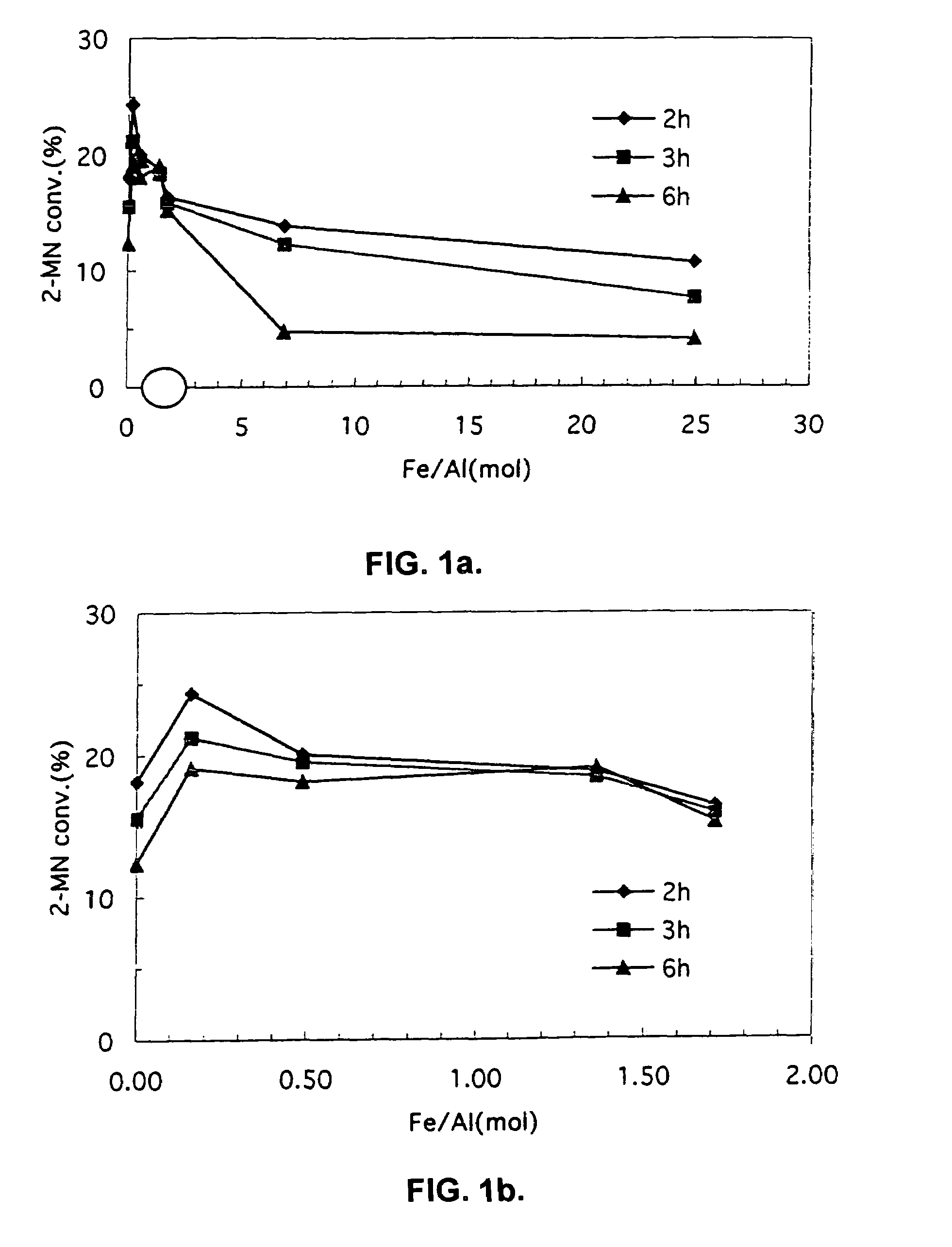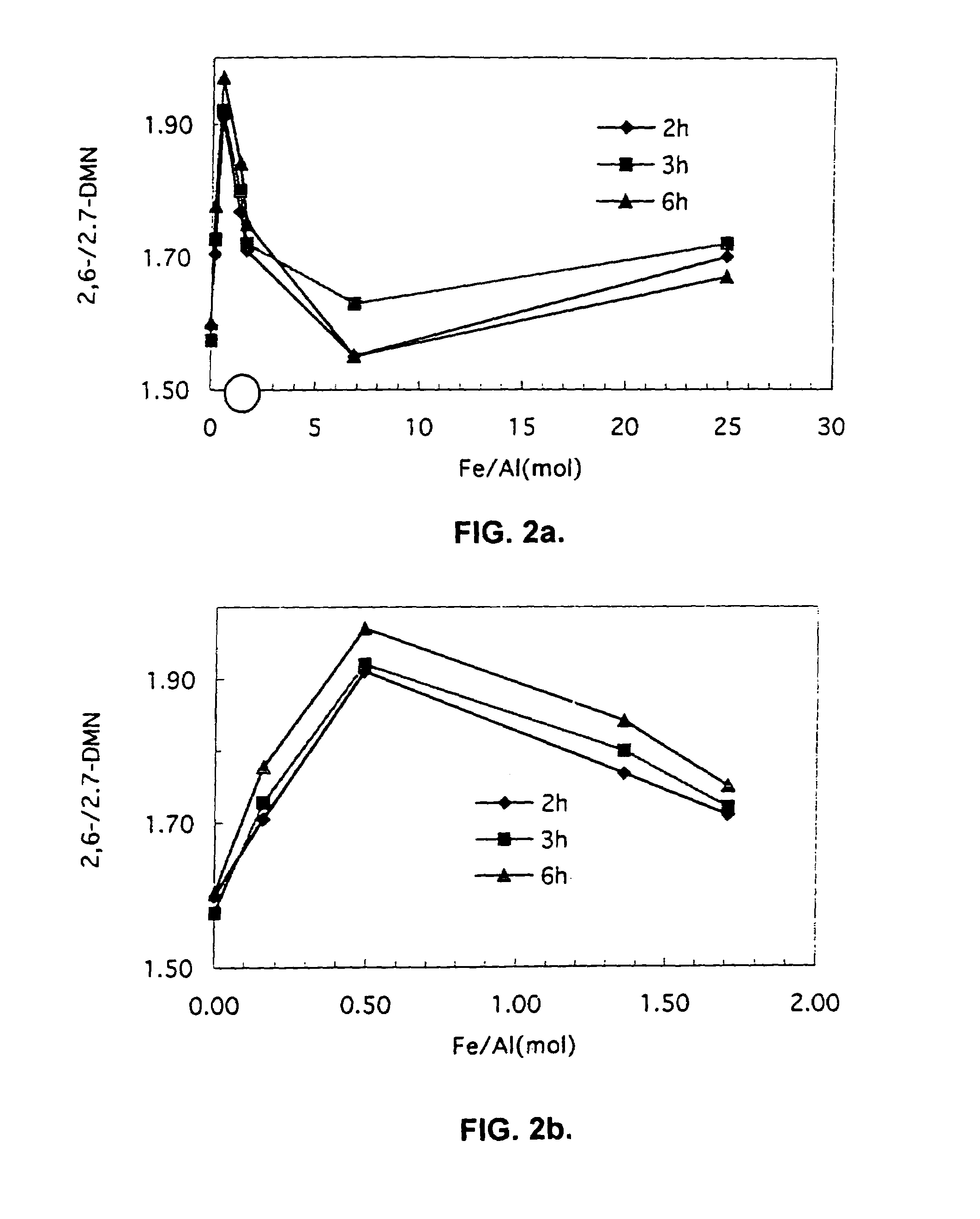Selective methylation catalyst, method of catalyst manufacture and methylation process
a selective methylation and catalyst technology, applied in the field of selective methylation catalyst, method of catalyst manufacture and methylation process, can solve the problems of high price per pound of 2,6-ndc, complex multi-step process, and insufficient combination of conversion and selectivity to achieve economic viability, and achieve high selectivity
- Summary
- Abstract
- Description
- Claims
- Application Information
AI Technical Summary
Benefits of technology
Problems solved by technology
Method used
Image
Examples
example 1
[0033]A solution containing 0.086 grams of FeF3 and 0.068 grams of NH4HF2 was dissolved in 100 milliliters of deionized water to provide a solution having a molar ratio of FeF3 to NH4HF2 of 2:3. This solution was added with rapid agitation over one hour at a temperature of 92° C. to a 10 weight percent slurry in water of ZSM-5 type material known as CBV5020E available from the PQ Corporation of Valley Forge, Pa. The slurry contained 5 grams of the ZSM-5 material.
[0034]This mixture was refluxed for 24 hours, filtered, washed with deionized water, dried for 12 hours at 110° C., and calcined at a temperature of 450° C. for five hours. The resulting catalyst exhibiting a Fe / Al molar ratio of 0.49 was then pressed into pellets and sieved into a proper size (10˜15 mesh) for use in the fixed bed reaction system.
[0035]Metal compounds useful for isomorphic substitution reactions preferably are soluble metal fluorides such as iron triflouride. Other useful soluble metal compounds will include...
example 2
[0039]A down-flow fixed bed reactor was loaded with 0.6 grams of catalyst comprising a mechanical mixture of 0.3 grams of the catalytic material prepared in Example 1 and 0.3 grams of a boehmite binder available as CAPTAPAL B ALUMINA from the Vista Chemical Company of Houston, Tex. The catalyst bed in the reactor was maintained at a temperature of 300° C. during the six-hour test period. Liquid feed containing methanol and 2-MN in a molar ratio of 5:1 was fed to the reactor at a rate of approximately 2 milliliters per hour, and an N2 carrier gas was fed to the reactor at a rate of approximately 20 milliliters per minute. The reactor effluent was analyzed by gas chromatography and yielded the results in Table 1, below.
[0040]
TABLE 1Measured ParameterResult2-methylnaphthalene conversion20%Selectivity to 2,6-DMN60%2,6-DMN to 2,7-DMN ratio2.2:1
[0041]As can be seen by comparing the results of Table 1 to the results reported for Fe-MFI catalysts described in the literature, the catalyst in...
examples 3 – 8
EXAMPLES 3–8
[0043]Catalyst was prepared as described in Example 1, except that the solution used to isomorphically substitute iron for aluminum in the ZSM-5 material was prepared by mixing the varying gram amounts of FeF3 and NH4HF2 specified in Table 2 in 100 milliliters of deionized water. Each resulting catalyst exhibited the Fe / Al ratio listed in Table 2. Each catalyst was used to selectively methylate 2-MN as described in Example 2, except where noted to the contrary. The 2-MN conversion and selectivity to 2,6-DMN also are listed in Table 2. A graphical summary of 2-MN conversion, selectivity to 2,6-DMN, the ratio of 2,6-DMN to all DMN's, and the overall yield of 2,6-DMN for Examples 1 through 8 appear in FIGS. 1 through 4.
[0044]
TABLE 2Exam-2-MNpleFeF3NH4HF2Fe / AlConver-2,6-DMN2,6 / 2,7Number(grams)(grams)RatiosionSelectivityDMN Ratio30.0430.0340.1624.340.41.7140.0860.0680.520.050.21.9150.1850.1391.3518.850.61.7660.2710.2051.7516.454.21.7170.740.567.013.854.51.5581.721.362510.756....
PUM
| Property | Measurement | Unit |
|---|---|---|
| weight percent | aaaaa | aaaaa |
| weight percent | aaaaa | aaaaa |
| run time | aaaaa | aaaaa |
Abstract
Description
Claims
Application Information
 Login to View More
Login to View More - R&D
- Intellectual Property
- Life Sciences
- Materials
- Tech Scout
- Unparalleled Data Quality
- Higher Quality Content
- 60% Fewer Hallucinations
Browse by: Latest US Patents, China's latest patents, Technical Efficacy Thesaurus, Application Domain, Technology Topic, Popular Technical Reports.
© 2025 PatSnap. All rights reserved.Legal|Privacy policy|Modern Slavery Act Transparency Statement|Sitemap|About US| Contact US: help@patsnap.com



